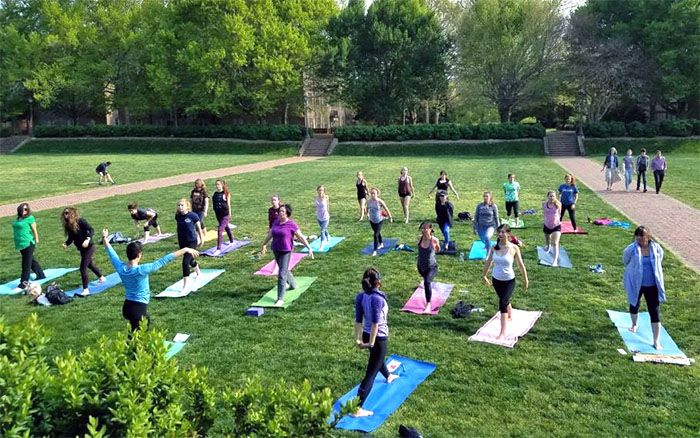What’s on the Wellness Menu?
A Smarter Way to Promote Health on Campus
Imagine this: A student organization reaches out for a presentation on stress management. A week later, a faculty member requests a session on flu prevention. Then, a Resident Assistant asks for something on healthy relationships. By midterm, your health promotion team is drowning in custom requests, duplicating efforts, and struggling to maintain consistency in messaging.
Sound familiar? That’s why having a structured, easy-to-access health education “menu” can streamline your wellness programming and ensure consistent, high-quality outreach across campus.
What Is a Health Education “Menu?”
Call it a menu, a catalog, or a toolkit—whatever fits your style. It’s a comprehensive collection of well-developed wellness and prevention topics, complete with ready-to-use materials and clear guidance for putting them into action.
Furthermore, campus stakeholders—including student groups, faculty, resident assistants, and student leaders—can simply select a topic from this curated catalog, making the entire collaboration process more efficient and effective.
These presentations typically include:
- Comprehensive slide decks with presenter notes
- Handouts and resource lists
- Interactive activities and discussion guides
- Tabling resources for awareness campaigns
- Assessment tools to measure impact
- Training materials for peer educators or co-presenters
Some institutions have expanded this model by empowering peer health advocates or building cross-departmental presenting teams that include staff from Counseling Centers, Recreation Services, and Academic Success offices—creating a more holistic approach to wellness education.
Why It Works
This structured format isn’t just convenient. It can also help your campus accomplish the following:
- Time Efficiency: Reduce preparation time for presentations after implementing a standardized wellness menu.
- Message Consistency: Improved clarity and consistency of messaging across multiple campus audiences.
- Resource Optimization: Campuses can reach more students without increasing staffing levels.
- Student Satisfaction: Higher satisfaction ratings for structured programs compared to ad hoc presentations.
- Assessment Quality: Stronger assessment data reported when using consistent programming formats.
Additionally, structured health education menus help institutions:
- Align programming with recognized wellness frameworks (like the National Wellness Alliance’s Six Dimensions of Wellness and the Okanagan Charter)
- Support formal partnerships between Counseling Services, Health Services, Student Activities, and Academic Affairs
- Empower peer health advocates with clear boundaries and well-designed materials
- Create predictable touchpoints throughout the student experience
- Facilitate more equitable access to health information across diverse campus populations
P.S. – Need help promoting these resources? Find five unique promotion ideas here.
What to Include in Your Health Education Menu
Additionally, when creating a health education menu for your campus, provide topics that are high-impact, relevant, and easy to deliver. Here’s a foundational list, gathered from health directors like you and based on trends we’re seeing across campuses nationwide:
Core Topics
- Alcohol and Substance Misuse Prevention
- Sexual Health & Safer Sex Practices
- How to Prioritize Sleep Hygiene
- Nutrition and Mindful Eating
- Physical Activity & Movement
- Consent and Healthy Boundaries
- Cold, Flu, and Infection Prevention
- Healthy Relationship Skills (romantic and platonic)
Mental Health & Emotional Well-being
- Burnout Prevention & Stress Management
- Homesickness & Adjustment to College Life
- Building Social Connections on Campus
- Mindfulness & Coping Skills for Anxiety
Academic & Intellectual Wellness
- Time Management & Focus
- Study-Life Balance
- How to Have a Healthy Relationship with Technology
Financial & Occupational Wellness
- Financial Literacy for College Students
- Managing Work and School
Optional Add-ons or Series
- The Six Dimensions of Wellness Series
- Emotional, Physical, Social, Intellectual, Financial, Spiritual
- Peer-Led Wellness Circles
- RA/Faculty Training Modules
Special Format Options
Tired of traditional, sit-and-listen health presentations? These engaging formats make wellness education interactive, hands-on, and more impactful for participants. Explore these workshop series and interactive activity ideas to keep students engaged:
Wellness Workshop Series
- The Six Dimensions of Wellness Series (Emotional, Physical, Social, Intellectual, Financial, Spiritual): Each session explores one of the six key wellness areas with discussion prompts, activities, and real-life strategies. Great for helping students understand how different aspects of their well-being are interconnected.
- Peer Relationship Series (progressive skill-building program): This series can focus on communication, conflict resolution, empathy, and setting boundaries. It’s designed to help students navigate friendships, dating, and roommate dynamics with confidence.
- Mindful Campus Series (progressive mindfulness skill development): Students can learn and practice mindfulness techniques over several sessions, including breathwork, body scans, and grounding strategies. Ideal for stress management and building emotional regulation skills.
- Body Positive Series (multi-session body image programming): This series explores media literacy, self-compassion, and inclusive wellness messages. Each session builds on the last to foster a healthier relationship with one’s body and appearance.
Interactive Formats
- Wellness Escape Rooms (interactive problem-solving focused on health topics): Students work together to solve themed puzzles that reinforce key health concepts (like sleep, nutrition, or consent). A fun and immersive way to engage with wellness education.
- Health Myth-Busting Events (quiz-show formats for groups): This fast-paced, game-style event helps debunk common health misconceptions through team challenges and trivia. Great for RA events, orientation weeks, or classroom takeovers.
- Wellness Fairs (multi-topic tabling with interactive components): Fairs bring together multiple campus and community partners to offer resources, giveaways, and hands-on activities. Think spin-the-wheel games, smoothie bike stations, or stress ball DIY tables.
- Peer-Led Wellness Circles (facilitated discussion groups): Small, supportive groups where trained peers guide conversations around mental health, identity, stress, and more. Encourages connection, validation, and shared coping tools.
Tips for Implementation
- Template Your Materials: Use a consistent slide deck format, a request form, and a follow-up survey.
- Create a Shared Folder: Make it easy for peer educators and staff to grab handouts, posters, or tabling talking points.
- Stay Data-Driven: Use attendance tracking and feedback forms to refine your topics and formats each semester.
- Pilot Before Scaling: Start with the top 5 requested topics, then grow the menu over time.
Key Takeaways
As a campus health leader, your impact goes far beyond delivering one-off programs—you’re shaping a sustainable system that empowers students to thrive, both now and in the future.
When done intentionally, health education has the power to shift campus culture in meaningful ways. Creating a campus-wide health education menu or toolkit isn’t just a means for organization—it’s a strategic step toward a healthier, more engaged student community.
Ready to enhance health and wellness efforts on your campus?
Explore how you can build a more accessible, inclusive, and effective wellness culture on your campus.






















